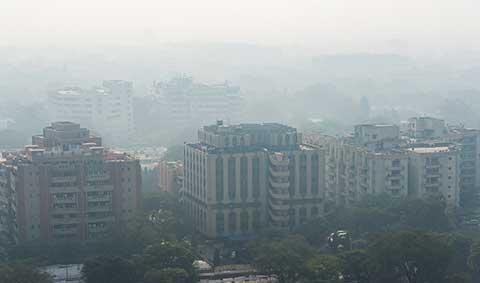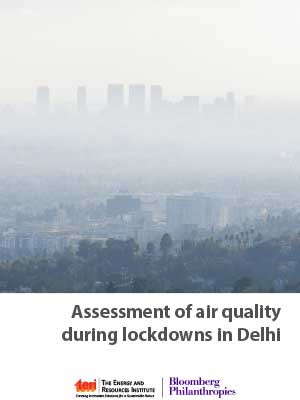Despite reductions in pollution, Delhi's air quality violated daily safety limits during lockdown: TERI

Regional sources of biomass burning and industries main contributors to Delhi's air pollution during lockdown, the report's findings suggest.
New Delhi, February 02, 2021: The statistical analysis of 32 CPCB monitoring stations of Delhi during lockdowns revealed an average reduction of 43% and 61% in Particulate Matter 2.5 (PM2.5) and Nitrogen Oxides (NOx) concentrations in 2020, with respect to 2019 despite reduced wind speeds and mixing heights.
However, a special air quality monitoring study conducted by TERI at three of its own monitoring stations in Delhi in Lodhi Road, Patel Nagar and Laxmi Nagar during a monitoring period of 45 days showed that despite the statistically significant reduction in PM2.5 and NOx levels in Delhi during the lockdowns, the PM2.5 levels still violated the daily safe limits, 31-60% of the monitoring days at the three locations.
This is one of the many key findings from a report on ‘Assessment of air quality during lockdowns in Delhi', released today by The Energy and Resources Institute (TERI), with the support of Bloomberg Philanthropies.
In spite of the restrictions at the local level curbing vehicular movement, construction activities along with functioning of several industries amidst the Covid-19 lockdowns, "contributions from upwind locations kept the pollution levels above the prescribed standards on many days during lockdowns in Delhi," the report said.
Biomass burning was found to be one of the key contributors to the high PM2.5 levels in Delhi and was mostly attributed to burning of wheat residue in farms and firewood in rural kitchens. Regional scale pollution from industries also contributed significantly to Delhi's pollution during lockdowns.
The study concludes that an airshed based approach needs to be adopted in order to address the problem of air pollution in Delhi.
Speaking on the occasion, Dr Ajay Mathur, Director General, TERI, said, "Unless we tackle regional sources with equal or more intensity we will not achieve air quality standards in Delhi. State governments need to come together and contribute."
Dr Sumit Sharma, Director, Earth Science and Climate Change Division, said, "Despite lockdowns and more dispersive meteorology in summers, the pollutant levels were way above the standards on most days. Focusing just on city level plans will not be enough, let's start preparing and implementing regional level air quality management plans in India."
Priya Shankar, India Director, Climate and Environment Program, Bloomberg Philanthropies said, "The Covid - 19 lockdown period provided a window to identify the underlying causes of air pollution in Delhi. This report highlights the importance of coordinated, collaborative and multi-level action for addressing air pollution to improve quality of life and protect public health."
A summary of key findings is as follows -
- Air pollution levels saw a statistically significant reduction of 43% and 61% in PM2.5 and NOx concentrations respectively during the lockdowns, when compared to 2019.
- Special monitoring was carried out at IHC, Laxmi Nagar, and Patel Nagar locations from 22nd April to 5th June. Despite in lockdowns, the PM2.5 levels violated the daily standard 60%, 47%, and 31% times at Lodhi Road, Laxmi Nagar, and Patel Nagar respectively.
- Contribution of pollutants was found to be lower from transport, and higher from biomass and industrial combustion activities, indicating regional contributions from outside Delhi.
- Analysis during lockdowns shows that vehicles and industries are important sectors contributing to PM2.5 concentrations in Delhi, and controls over them (as during the lockdown) can lead to significant reductions in PM2.5 concentrations.
- Biomass burning and industries are the significant sources contributing to the deterioration of air quality at the regional scale and, despite lockdown, continue to pollute in substantial quantities.
- Significantly high pollutant levels observed in Delhi despite all the restrictions, point towards substantial contributions of several non-local sources and the need for delineation of Delhi's airshed and also for other non-attainment cities for the development of effective air quality management plans.
About TERI
The Energy and Resources Institute (TERI) is an independent, multi-dimensional organisation, with capabilities in research, policy, consultancy and implementation. It has pioneered conversations and action in the energy, environment, climate change, and sustainability space for over four decades.
The institute's research and research-based solutions have had a transformative impact on industry and communities. Headquartered in New Delhi, it has regional centres and campuses in Gurugram, Bengaluru, Guwahati, Mumbai, Panaji, and Nainital, supported by a multi-disciplinary team of scientists, sociologists, economists and engineers, and state-of-the-art infrastructure.
For further information, contact: shreyas.joshi@teri.res.in


